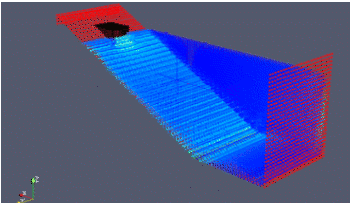







From SPHYSICS
| Line 1: | Line 1: | ||
__NOTOC__ | __NOTOC__ | ||
| − | ==== <big>''' | + | ==== <big>'''SPHysics - SPH Free-surface Flow Solver''' </big> ==== |
<small>''' Open-Source Smoothed Particle Hydrodynamics code''' </small> | <small>''' Open-Source Smoothed Particle Hydrodynamics code''' </small> | ||
| Line 9: | Line 9: | ||
[[Image:Sphysics_home_page2.gif|frame]] | [[Image:Sphysics_home_page2.gif|frame]] | ||
| − | #'''Welcome to | + | #'''Welcome to SPHysics''' |
#'''[[Contributors| Contributors]]''' | #'''[[Contributors| Contributors]]''' | ||
#'''[[Downloads| Downloads]]''' | #'''[[Downloads| Downloads]]''' | ||
#'''[[Documentation| Documentation]]''' | #'''[[Documentation| Documentation]]''' | ||
| − | #'''[[SPHYSICS FAQ| | + | #'''[[SPHYSICS FAQ| SPHysics FAQ]]''' |
| − | #'''[[SPHYSICS Forum| | + | #'''[[SPHYSICS Forum| SPHysics Forum]]''' |
#'''[[Visualization| Visualization & Images]]''' | #'''[[Visualization| Visualization & Images]]''' | ||
#'''[[Code History| Code History & Fixed Bugs]]''' | #'''[[Code History| Code History & Fixed Bugs]]''' | ||
#'''[[#Future Developments| Future Developments]]''' | #'''[[#Future Developments| Future Developments]]''' | ||
| − | #'''[[SPHYSICS Publications| Publications using the | + | #'''[[SPHYSICS Publications| Publications using the SPHysics code]]''' |
#'''[[#Links| Links - SPHERIC]]''' | #'''[[#Links| Links - SPHERIC]]''' | ||
| − | #'''[[Help:Contents| Help and Info about | + | #'''[[Help:Contents| Help and Info about SPHysics website]]''' |
<br> | <br> | ||
| − | <big>'''The | + | <big>'''The SPHysics Code'''</big> |
| − | + | SPHysics is a Smoothed Particle Hydrodynamics (SPH) code inspired by the formulation of Monaghan (1992) developed jointly by researchers at the Johns Hopkins University (U.S.A.), the University of Vigo (Spain), the University of Manchester (U.K.) and the University of Rome La Sapienza (Italy). We are excited to announce that the first official release of version 1.0 of SPHysics is now available. | |
This code version is the basic version and incorporates the following features: | This code version is the basic version and incorporates the following features: | ||
:*2-D and 3-D versions | :*2-D and 3-D versions | ||
| − | :* | + | :*Variable timestep |
:*Choice of two types of solid boundary condition: dynamic and repulsive force | :*Choice of two types of solid boundary condition: dynamic and repulsive force | ||
:*Periodic open boundary conditions | :*Periodic open boundary conditions | ||
| Line 44: | Line 44: | ||
| − | '''[[Downloads| Download | + | '''[[Downloads| Download SPHysics now!]]''' |
| Line 55: | Line 55: | ||
*floating bodies | *floating bodies | ||
*parallelization | *parallelization | ||
| − | *couple | + | *couple SPHysics to long wave propagation model |
== Links == | == Links == | ||
| − | All developers of the | + | All developers of the SPHysics code are members of '''SPHERIC''' which is the |
'''SPH European Research Interest Community'''. | '''SPH European Research Interest Community'''. | ||
This organisation seeks to promote the development and use of SPH within the academic and industrial communities. Click here for the [http://wiki.manchester.ac.uk/spheric SPHERIC Home Page] | This organisation seeks to promote the development and use of SPH within the academic and industrial communities. Click here for the [http://wiki.manchester.ac.uk/spheric SPHERIC Home Page] | ||
Revision as of 09:29, 28 August 2007
SPHysics - SPH Free-surface Flow Solver
Open-Source Smoothed Particle Hydrodynamics code
RELEASED: 1st AUGUST 2007
- Welcome to SPHysics
- Contributors
- Downloads
- Documentation
- SPHysics FAQ
- SPHysics Forum
- Visualization & Images
- Code History & Fixed Bugs
- Future Developments
- Publications using the SPHysics code
- Links - SPHERIC
- Help and Info about SPHysics website
The SPHysics Code
SPHysics is a Smoothed Particle Hydrodynamics (SPH) code inspired by the formulation of Monaghan (1992) developed jointly by researchers at the Johns Hopkins University (U.S.A.), the University of Vigo (Spain), the University of Manchester (U.K.) and the University of Rome La Sapienza (Italy). We are excited to announce that the first official release of version 1.0 of SPHysics is now available.
This code version is the basic version and incorporates the following features:
- 2-D and 3-D versions
- Variable timestep
- Choice of two types of solid boundary condition: dynamic and repulsive force
- Periodic open boundary conditions
- Choice of:
- Artificial Viscosity
- Laminar Viscosity
- Sub-Particle Scale (SPS) Turbulence Model
- Different Types of Moving Objects (forced motion only)
- Moving Gate
- Wavemaker
- Sliding Wedge
- Visualization routines using Matlab or ParaView
The code has been developed over a number of years primarily to study free-surface flow phenomena where Eulerian methods can be difficult to apply, such as waves, impact of dam-breaks on off-shore structures. Furthermore, the meshfree technique facilitates the simulation of highly distorted fluids/bodies.
Future Developments
Extensions of the code are already underway to add the following features to the SPHYSICS code:
- floating bodies
- parallelization
- couple SPHysics to long wave propagation model
Links
All developers of the SPHysics code are members of SPHERIC which is the
SPH European Research Interest Community.
This organisation seeks to promote the development and use of SPH within the academic and industrial communities. Click here for the SPHERIC Home Page
